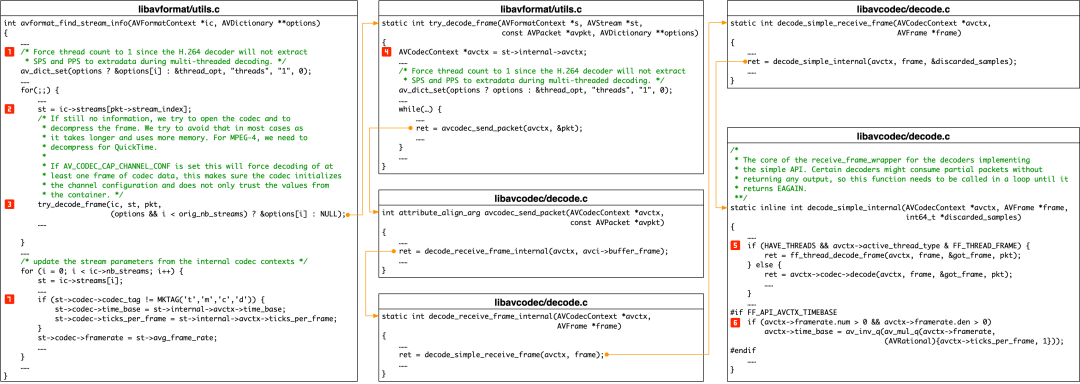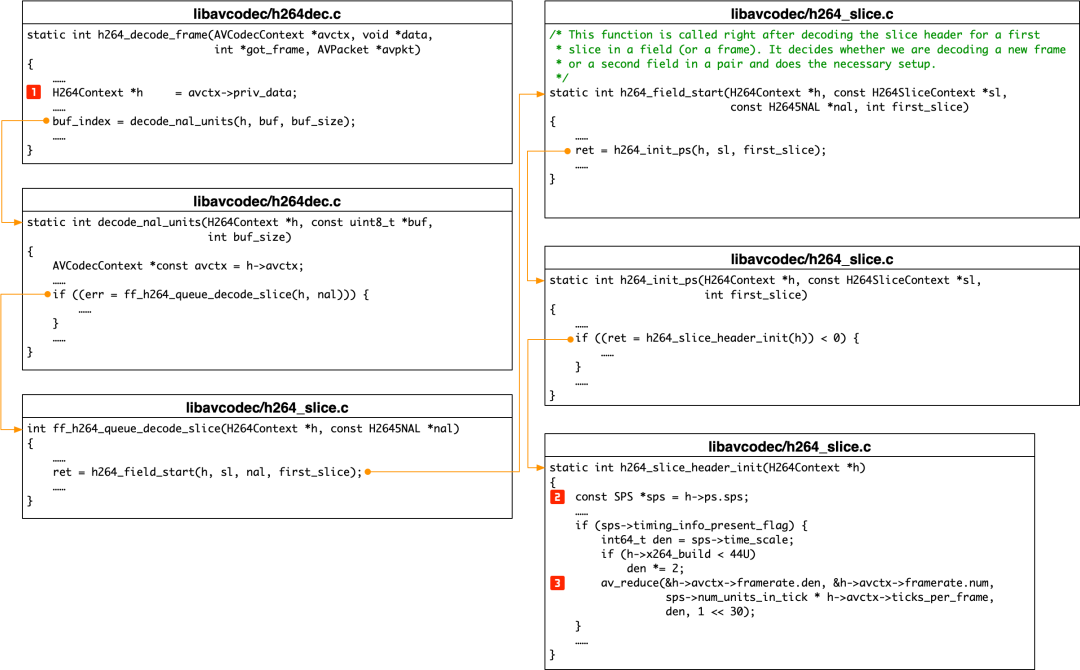- 1[Linux] Apache Gateway Timeout_the gateway did not receive a timely response from
- 2Cherry-Pick | 一日一 Git
- 3基于gitlab的CICD流程规范
- 4漏洞扫描的那些事,怎样通过IP就能发现目标漏洞?你应该知道的事_怎么利用ip找网站漏洞
- 5C++杂碎知识点_char数组拷贝
- 6Python 更换源的方法_python换源
- 7Python GUI 新手入门教程:轻松构建图形用户界面_pythongui
- 8点点点(功能测试 黑盒)的测试人员,如何提升自己?_工作中都是点点点,怎么提升自己的测试能力
- 9【解决Android Studio】Could not resolve com.android.tools.build:gradle:7.4.1
- 10PostgreSQL解决死锁_pg idle in transaction 产生锁
为什么 OpenCV 计算的视频 FPS 是错的_opencv/modules/videoio/src/cap_ffmpeg_impl.hpp:233
赞
踩

作者 | 王伟、刘一卓
导读
网络直播功能作为一项互联网基本能力已经越来越重要,手机中的直播功能也越来越完善,电商直播、新闻直播、娱乐直播等多种直播类型为用户提供了丰富的直播内容。
随着直播的普及,为用户提供极速、流畅的直播观看体验我们有一个平台来周期性的对线上的直播流数据进行某些检测,例如黑/白屏检测、静态画面检测……
在检测中,我们会根据提取到的直播流的帧率来预估要计算的帧数量,例如如果要检测 5s 的直播流,而该直播流的帧率为 20 fps,需要计算的帧数量则为 100。忽然有一天,我们发现,平台开始大面积的超时,之前只需要 2s 就能完成的计算,现在却需要 30+ 分钟。
查了之后,我们发现,之所以计算超时是因为 OpenCV 计算的帧率为 2000,从而导致需要计算的帧数量从之前的 100 变为了 10000,进而引起了计算超时。
全文9288字,预计阅读时间24分钟。
01 OpenCV 如何计算帧率
这个问题的具体描述可以参见 OpenCV Issues 21006。该问题的模拟直播流片段 test.ts 可以点击链接(https://pan.baidu.com/share/init?surl=RY0Zk5C_DOEwTXYe2SLFEg)下载,下载提取码为 x87m。
如果用如下的代码获取 test.ts 的 fps,
const double FPS = cap.get(cv::CAP_PROP_FPS);
std::cout << "fps: " << FPS << std::endl;
- 1
- 2
可以得到:
$ fps: 2000
- 1
用 ffprobe 对视频进行分析,
$ ffprobe -select_streams v -show_streams test.ts
- 1
可以得到:
codec_name=h264
r_frame_rate=30/1
avg_frame_rate=0/0
……
- 1
- 2
- 3
- 4
从 opencv/modules/videoio/src/cap_ffmpeg_impl.hpp 中,我们发现 fps 由 CvCapture_FFMPEG::get_fps() 计算而来,其计算逻辑如下:
double fps = r2d(ic->streams[video_stream]->avg_frame_rate);
if (fps < eps_zero) {
fps = 1.0 / r2d(ic->streams[video_stream]->codec->time_base);
}
- 1
- 2
- 3
- 4
02 为什么 OpenCV 得到的帧率是错的
利用 test_time_base.cpp,我们可以得到:
time_base: 1/2000
framerate: 0/0
avg_framerate: 0/0
- 1
- 2
- 3
r2d(ic->streams[video_stream]->avg_frame_rate) = 0
- 1
所以 OpenCV 采用了:
1.0 / r2d(ic->streams[video_stream]->codec->time_base)
- 1
来计算该视频的 fps。而此处的 time_base = 1/2000,因此,最终得到的 fps 是 2000。
也就是说,AVStream->codec->time_base 的值导致了 OpenCV 得到一个看起来是错误的 fps。那么,AVStream->codec->time_base 为什么是这个数呢?FFMpeg 是怎么计算这个字段的呢?
03 FFMpeg 如何计算 AVCodecContext.time_base
AVStream->codec->time_base 是 AVCodecContext 中定义的 time_base 字段,根据 libavcodec/avcodec.h中的定义,该字段的解释如下:
/** * This is the fundamental unit of time (in seconds) in terms * of which frame timestamps are represented. For fixed-fps content, * timebase should be 1/framerate and timestamp increments should be * identically 1. * This often, but not always is the inverse of the frame rate or field rate * for video. 1/time_base is not the average frame rate if the frame rate is not * constant. * * Like containers, elementary streams also can store timestamps, 1/time_base * is the unit in which these timestamps are specified. * As example of such codec time base see ISO/IEC 14496-2:2001(E) * vop_time_increment_resolution and fixed_vop_rate * (fixed_vop_rate == 0 implies that it is different from the framerate) * * - encoding: MUST be set by user. * - decoding: the use of this field for decoding is deprecated. * Use framerate instead. */ AVRational time_base;
- 1
- 2
- 3
- 4
- 5
- 6
- 7
- 8
- 9
- 10
- 11
- 12
- 13
- 14
- 15
- 16
- 17
- 18
- 19
- 20
从中可以看出,对于解码而言,time_base 已经被废弃,需要使用 framerate 来替换 time_base。并且,对于固定帧率而言,time_base = 1/framerate,但是,并非总是如此。
利用 H264Naked 对 test.ts 对应的 H264 码流进行分析,我们得到 SPS.Vui 信息:
timing_info_present_flag :1
num_units_in_tick :1
time_scale :2000
fixed_frame_rate_flag :0
- 1
- 2
- 3
- 4
从中可以看到,test.ts 是非固定帧率视频。从 test_time_base.cpp 的结果看,test.ts 视频中,framerate = 0/0,而 time_base = 1/2000。
难道,对于非固定帧率视频而言,time_base 和 framerate 之间没有关联?如果存在关联,那又是怎样的运算才能产生这种结果?这个 time_base 究竟是怎么计算的呢?究竟和 framerate 有没有关系呢?一连串的问题随之而来……
源码面前,了无秘密。接下来,带着这个问题,我们来一起分析一下 FFMpeg 究竟是如何处理 time_base 的。
04 avformat_find_stream_info
在 FFMpeg 中,avformat_find_stream_info() 会对 ic->streams[video_stream]->codec 进行初始化,因此,我们可以从 avformat_find_stream_info() 开始分析。
从 libavformat/avformat.h 中,可以得知avformat_open_input()会打开视频流,从中读取相关的信息,然后存储在AVFormatContext中,但是有时候,此处获取的信息并不完整,因此需要调用**avformat_find_stream_info()**来获取更多的信息。
* @section lavf_decoding_open Opening a media file * The minimum information required to open a file is its URL, which * is passed to avformat_open_input(), as in the following code: * @code * const char *url = "file:in.mp3"; * AVFormatContext *s = NULL; * int ret = avformat_open_input(&s, url, NULL, NULL); * if (ret < 0) * abort(); * @endcode * The above code attempts to allocate an AVFormatContext, open the * specified file (autodetecting the format) and read the header, exporting the * information stored there into s. Some formats do not have a header or do not * store enough information there, so it is recommended that you call the * avformat_find_stream_info() function which tries to read and decode a few * frames to find missing information.
- 1
- 2
- 3
- 4
- 5
- 6
- 7
- 8
- 9
- 10
- 11
- 12
- 13
- 14
- 15
- 16
需要注意的是:avformat_find_stream_info() 会尝试通过解码部分视频帧来获取需要的信息。
/** * Read packets of a media file to get stream information. This * is useful for file formats with no headers such as MPEG. This * function also computes the real framerate in case of MPEG-2 repeat * frame mode. * The logical file position is not changed by this function; * examined packets may be buffered for later processing. * * @param ic media file handle * @param options If non-NULL, an ic.nb_streams long array of pointers to * dictionaries, where i-th member contains options for * codec corresponding to i-th stream. * On return each dictionary will be filled with options that were not found. * @return >=0 if OK, AVERROR_xxx on error * * @note this function isn't guaranteed to open all the codecs, so * options being non-empty at return is a perfectly normal behavior. * * @todo Let the user decide somehow what information is needed so that * we do not waste time getting stuff the user does not need. */ int avformat_find_stream_info(AVFormatContext *ic, AVDictionary **options);
- 1
- 2
- 3
- 4
- 5
- 6
- 7
- 8
- 9
- 10
- 11
- 12
- 13
- 14
- 15
- 16
- 17
- 18
- 19
- 20
- 21
- 22
avformat_find_stream_info() 的整体逻辑大致如下图所示,其中特别需要关注图中所示的 7 个步骤:

avformat_find_stream_info() 的重要步骤说明
-
STEP 1. 设置线程数,避免 H264 多线程解码时没有把 SPS/PPS 信息提取到 extradata。
-
STEP 2. 设置 *AVStream st,st 会在后续的函数调用中一直透到 try_decode_frame()。
-
STEP 4. 设置 *AVCodecContext avctx 为透传的 st->internal->avctx,在后续的解码函数调用中,一直透传的就是这个 avctx,因此,从这里开始的执行流程,FFMpeg 使用的全部都是 st->internal->avctx,而不是 st->codec,这里要特别的注意。此处同时会设置解码的线程数,其目的和 STEP 1是一致的。
-
STEP 5. 因为之前设置了解码线程数为 1,因此此处会调用
ret = avctx->codec->decode(avctx, frame, &got_frame, pkt)
- 1
来解码并计算 avctx->framerate。注意,此处的 avctx 实际上是透传而来的 st->internal->avctx。计算 framerate 的逻辑会在 如何计算 framerate 介绍。
- STEP 6. 根据解码器得到的 framerate 信息来计算 avctx->time_base,注意此处实际上是 st->internal->avctx->time_base。根据 下文 framerate 的计算 可知,此处 framerate = {1000, 1}。根据 AVCodecContext.ticks_per_frame 的介绍 可知,ticks_per_fram****e = 2。因此,此处 avctx->time_base = {1, 2000}:
avctx->time_base = av_inv_q(av_mul_q({1000, 1}, {2, 1})) = {1, 2000}
- 1
- STEP 7. 这一步可谓是“瞒天过海,明修栈道暗度陈仓”,这一步为了解决 API 的前向兼容,做了一个替换,把 st->internal->avctx->time_base 赋值给了 st->codec->time_base,而把 st->avg_frame_rate 赋值给了 st->codec->framerate。因此:
st->codec->time_base = {1, 2000}
st->codec->framerate = {0, 0}
- 1
- 2
st->codec->time_base 的计算和 st->codec->framerate 之间没有任何关系,而是和 st->internal->avctx->framerate 有关。本质而言,和 sps.time_scale,sps.num_units_in_tick 有关。
st->internal->avctx->time_base.num = sps->num_units_in_tick *
st->internal->avctx->ticks_per_frame
st->internal->avctx->time_base.den = sps->time_scale *
st->internal->avctx->ticks_per_frame;
st->internal->avctx->time_base = {sps->num_units_in_tick, sps->time_scale}
- 1
- 2
- 3
- 4
- 5
- 6
- 7
internal->avctx->time_base & internal->framerate
-
所以实际上,internal->avctx->time_base 为:
avctx->time_base = sps->num_units_in_tick / sps->time_scale- 1
-
而,internal->avctx->framerate 则是:
avctx->time_base = sps->num_units_in_tick / sps->time_scale- 1
因此,对于 H264 码流而言,time_base = 1 / (2 * framerate),而不是 1 / framerate。
这也就是为什么 libavcodec/avcodec.h 中说:
* This often, but not always is the inverse of the frame rate or field rate * for video.- 1
- 2
从如上的分析可以知道:
avctx->framerate = 1 / (avctx->time_base * avctx->ticks_per_frame)- 1
因此,当 st->avg_frame_rate = 0 时,OpenCV 计算 fps 的逻辑 是错误的。
在 H265 中,ticks_per_frame = 1,因此对于 H265 的编码,OpenCV 是没有这个问题的。可以使用 Zond 265工具来分析一个 H265 的视频码流,然后对照 OpenCV 以及 FFMpeg 的结果来验证。
同时,正是如上所示的 STEP 7 中的移花接木导致了 test_time_base.cpp 的结果:
st->codec->framerate: 0/0
st->codec->time_base: 1/2000
- 1
- 2
05 ff_h264_decoder
libavcodec/decode.c 中的 decode_simple_internal() 中会调用对应的解码器来进行解码(STPE 5)。而正如前所示,test.ts 为 H264 编码的视频流,因此,此处会调用 H264 解码器来进行解码。在 FFMpeg 中,H264 解码器位于 libavcodec/h264dec.c 中定义的 const AVCodec ff_h264_decoder。
const AVCodec ff_h264_decoder = {
.name = "h264",
.type = AVMEDIA_TYPE_VIDEO,
.id = AV_CODEC_ID_H264,
.priv_data_size = sizeof(H264Context),
.init = h264_decode_init,
.close = h264_decode_end,
.decode = h264_decode_frame,
......
};
- 1
- 2
- 3
- 4
- 5
- 6
- 7
- 8
- 9
- 10
在上文图中的 STPE 5 中,
ret = avctx->codec->decode(avctx, frame, &got_frame, pkt);
- 1
实际调用的就是
ff_h264_decoder->h264_decode_frame(avctx, frame, &got_frame, pkt);
- 1
而此处的 avctx 也就是 try_decode_frame() 中的透传下来的 st->internal->avctx,即上文图中的 STEP 4。
06 h264_decode_frame
h264_decode\frame() 的整体逻辑如下图所示:

AVCodecContext.ticks_per_frame
后面会用到 ticks_per_frame 来计算 framerate。在 STEP 6 中计算 time_base 的时候也用到了该值。因此,有必要做一下特殊说明。在 H264 解码器中,ticks_per_frame=2,其具体的取值可以从如下几处得知:
libavcodec/avcodec.h 中的字段说明:
/**
* For some codecs, the time base is closer to the field rate than the frame rate.
* Most notably, H.264 and MPEG-2 specify time_base as half of frame duration
* if no telecine is used ...
*
* Set to time_base ticks per frame. Default 1, e.g., H.264/MPEG-2 set it to 2.
*/
int ticks_per_frame;
- 1
- 2
- 3
- 4
- 5
- 6
- 7
- 8
libavcodec/h264dec.c 中的 h264_decode_init():
avctx->ticks_per_frame = 2;
- 1
07 如何计算 framerate
如何计算 st->internal->avctx->framerate
-
STEP 1. 根据整体的计算流程可知,此处的 h 实际上就是 avformat_find_stream_info() 中的 st->internal->avctx->priv_data。h 会一直透传到之后的所有流程,这个务必要注意。
-
STEP 2. 此处会首先获取到 sps 的相关信息,以备后续的计算使用,我们可以再次看一下 test.ts sps 的相关信息。
timing_info_present_flag :1
num_units_in_tick :1
time_scale :2000
fixed_frame_rate_flag :0
- 1
- 2
- 3
- 4
- STEP 3. 根据 sps 的相关信息计算 framerate,在上文的 STEP 6 中计算 time_base 用到的 framerate 就是在此处计算的。因为 timing_info_present_flag = 1,因此会执行计算 framerate 的逻辑:
avctx->framerate.den = sps->num_units_in_tick * h->avctx->ticks_per_frame = 1 * 2 = 2
avctx->framerate.num = sps->time_scale = 2000
avctx->framerate = (AVRational){1000, 1}
- 1
- 2
- 3
因此,
st->internal->avctx->framerate = {1000, 1}
- 1
08 结论
通过如上的分析我们可以知道:
-
FFMpeg 在计算 AVCodecContex 中的 framerate 和 time_base 的时候,会用到:
-
sps.time_scale
-
sps.num_units_in_tick
-
AVCodecContex.ticks_per_frame
-
在 FFMpeg 中,framerate 和 time_base 的关系为:
-
framerate = 1 / (time_base * ticks_per_frame)
-
time_base = 1 / (framerate * ticks_per_frame)
-
对于非 H.264/MPEG-2,ticks_per_frame=1,因此 framerate 和 time_base 是互为倒数的关系。而对于 H.264/MPEG-2 而言,ticks_per_frame=2,因此,此时,二者并非是互为倒数的关系。因此,FFMpeg 中才说,framerate 和 time_base 通常是互为倒数的关系,但并非总是如此。
-
在 OpenCV 中,对于 H.264/MPEG-2 视频而言,当 AVStream.avg_frame_rate=0 时,其计算 fps 的逻辑存在 BUG。
-
因为在解码时,AVCodecContex.time_base 已经废弃,同时 AVStream.avctx 也已经废弃,而 avformat_find_stream_info() 中为了兼容老的 API,因此会利用 AVStream.internal.avctx 和其他的信息来设置 AVStream.avctx。而 AVStream.avctx.time_base 取自 AVStream.internal.avctx,AVStream.avctx.framerate 则取自 AVStream.framerate。
————END————
推荐阅读:





